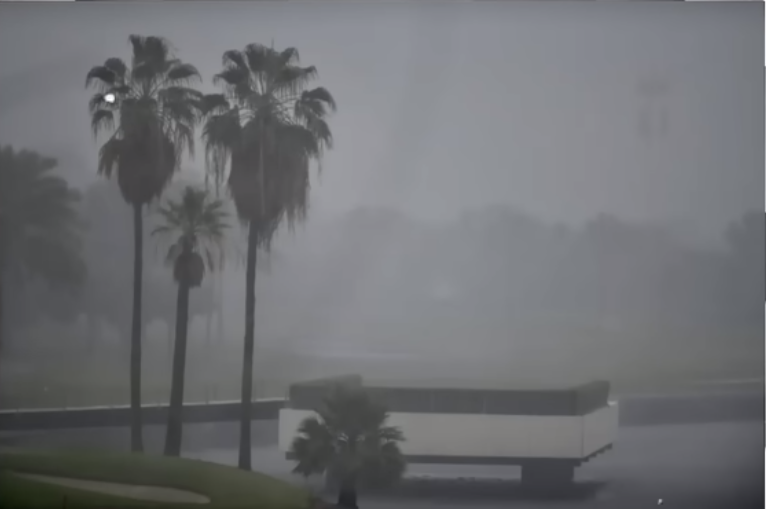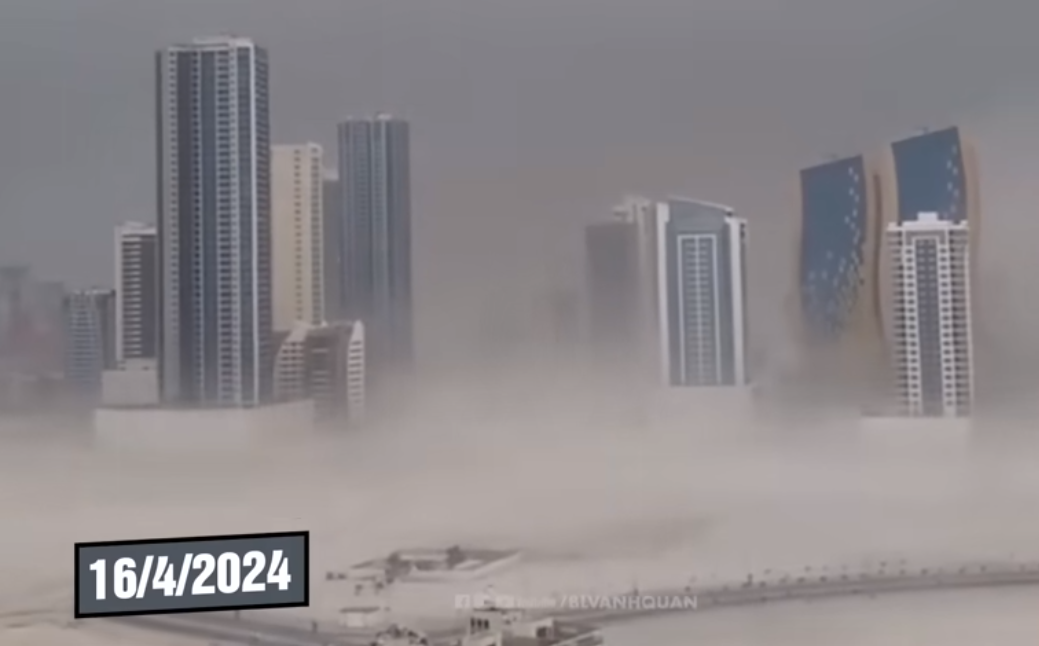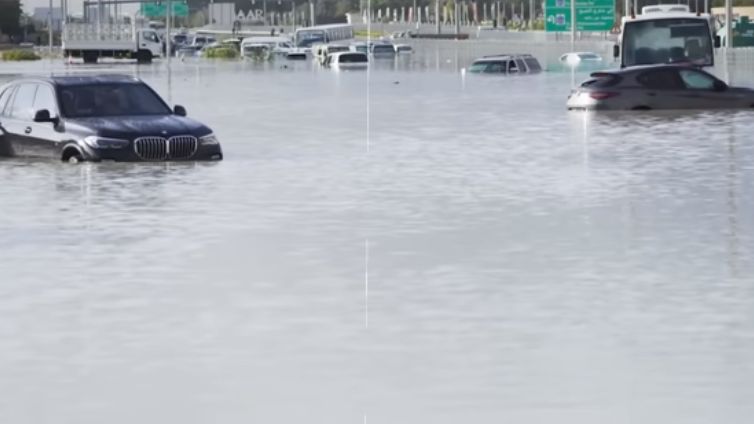Dubai is the most famous city of the United Arab Emirates (UAE), resembling other places in the region known for its arid deserts and seemingly endless stretches of hot sand dunes. However, on April 16, the desert, usually accustomed to the heat and dryness, was inundated with heavy rains, creating unprecedented scenes. Major roads in Dubai turned into rivers, and vehicles were left stranded on the streets. Dubai International Airport, one of the busiest airports in the world, advised people not to travel unless in emergencies, as most flights were delayed or diverted.
What caused such severe flooding in the desert?
On April 16, Dubai recorded 142 mm of rain, more than the total annual rainfall the desert city typically receives. Many cars were left abandoned on the roads, and residents had to wait for rescue teams to assist them, with supercars also stranded along the six-lane highways. Police reported that a 70-year-old man died after being swept away in his car in Rasakhaima. The rain fell so heavily and quickly that some drivers were forced to abandon their vehicles as floodwaters rose and roads turned into rivers.

Dubai, known for its hot and dry climate, rarely experiences rain, so urban infrastructure is not built to cope with such large-scale rainfall. Many residents were stranded on the streets as their vehicles could not move due to the deep flooding. Numerous cars stalled; Dubai residents are accustomed to the hot dry climate and thus have no experience dealing with flooding incidents like this. Other public transport options, such as taxis and buses, naturally could not operate. The subway stations in this wealthy city were flooded, leading to a temporary suspension of services. Even if they could run, residents would still have to walk a distance to get home, facing dangerously deep water that was over knee-high.
Many people stranded had to sleep at train stations, bus stops, or the airport, waiting for the rain to subside and the waters to recede before they could move. To cope with the weather situation, authorities acted quickly to close schools and shift to remote work to ensure safety. Emergency services moved through the heavily flooded streets deploying tankers to pump out water. At Dubai International Airport, check-in for flights departing from Dubai was temporarily suspended on the morning of April 17 due to operational challenges caused by bad weather and road conditions. The low-cost airline Fly Dubai canceled all flights until 10:00 AM on April 17, with shocking video footage showing the runway of Dubai International Airport, recently the second busiest airport in the world, submerged as large aircraft struggled to move through the floodwaters.
Large aircraft resembled boats moving through the airport, splashing water and bobbing in deep floodwaters. The airport ceased operations for nearly half an hour on April 16, with flights significantly disrupted due to the extensive flooding on the roads surrounding Dubai, leading to an airport announcement. Videos from social media showed water flooding through a shopping center in the area and inundating the ground floors of homes. Dubai, like the rest of the United Arab Emirates, has a hot and dry climate, so rainfall in Dubai is infrequent, and infrastructure is not prepared to handle extreme weather events. This has been recorded as the largest rainfall in the past 75 years in the Dubai area.
The flooding in Dubai is linked to a major storm passing through the Arabian Peninsula and moving across the Gulf of Oman. This storm also brought unusual wet weather to neighboring Oman and southeastern Iran, having swept through Oman before hitting Dubai in the United Arab Emirates. Prolonged heavy rain and flooding have resulted in at least 18 fatalities in Oman over the past few days, with rain gradually decreasing in the area on the evening of April 16, but some showers may continue on April 17 before the weather returns to dry conditions.
Dubai has one of the best public infrastructures in the world due to significant financial investment. This funding primarily comes from oil, bringing unprecedented prosperity to this city and the Middle East region as a whole. However, the drainage system in Dubai is almost nonexistent, as they typically only experience one or two significant rain events a year. It is difficult to find drainage systems on the streets, so heavy rains like those recently have caused widespread flooding that the authorities could not respond to in time, and residents were completely unprepared as they had never witnessed such flooding before. After this historic once-in-a-hundred-years rain in Dubai, public opinion is suggesting that the real culprit behind the recent unusual flooding in the desert city is artificial rain technology.

Due to the year-round hot and dry conditions, the United Arab Emirates frequently uses artificial rain technology to cool the air and facilitate agriculture. To induce rain from a cloud, tiny salt particles such as silver, calcium chloride, or potassium chloride need to be sprayed into it. The UAE, like many other countries, has been conducting this activity for a long time, using aircraft or ground machinery to inject these substances into the air currents to bring them up to the clouds. These particles have a crystalline structure similar to ice, creating a surface for water droplets to adhere to. Water condenses to form ice crystals and eventually falls as snow or rain; artificial rain cannot create clouds from nothing. It helps available moisture in the atmosphere condense faster and produce rain in certain areas.
Therefore, first, you need humidity; without humidity, there will be no clouds, which is similar to the natural rain process occurring in clouds. However, many atmospheric scientists have dismissed the notion that artificial rain is the cause of flooding in Dubai. Experts believe that the rains in Dubai originated from a rare dragon system that had been forecasted to bring heavy rain. The real issue here is that humanity has not been able to gradually eliminate fossil fuels, so we must prepare for unprecedented extreme weather conditions that will only worsen until we achieve net-zero emissions.

Rising global temperatures lead to heavier rains across the planet, even in arid regions or even in the midst of droughts. This extreme weather phenomenon occurs due to a basic physical principle: warm air holds more water. Any potential impact of artificial rain in these situations would be minimal. Torrential rains like those on April 16 will become more frequent due to human-induced climate change. As the atmosphere continues to warm, it can absorb more moisture, like a sponge, and then release it as more extreme flooding rains.
Ms. Esra Anabi, a senior forecaster at the UAE National Meteorological Center, stated that climate change may have an impact, whether directly or indirectly, but it should be clarified that this storm occurred in April, a month when extreme or rare weather events often happen. According to Ms. Colin Colia, a climate scientist at Imperial College London, with climate change, we have seen many intensities of storms increase with heavy rainfall; the storm has intensified due to climate change, leading to more moisture in the atmosphere. According to meteorological data collected at Dubai International Airport, rain began late on April 15, with approximately 20 mm of rainfall. The storms intensified around 9:00 AM on April 16 and continued throughout the day.

By the end of April 16, the rainfall of over 142 mm had flooded Dubai for more than 24 hours. Rain is an unusual phenomenon in the UAE but occurs periodically during the winter months. The drainage infrastructure in many roads and areas in Dubai is not suitable for heavy rainfall. Therefore, flooding is likely to occur, with initial estimates indicating that this rainfall caused over 30 mm of rain on the morning of April 16 in Dubai, with total rainfall expected for the day at 128 mm. In fact, the UAE is not the only desert or drought-affected area that has been devastated by flooding in recent years.
Death Valley National Park in California, known as one of the hottest and driest places on Earth, has witnessed historic flooding in 2022 and 2023 this February. If humanity continues to burn fossil fuels and coal, the climate will continue to warm, rainfall will increase, and people will continue to die from flooding. Climate change causes many unprecedented extreme phenomena, where it should rain heavily, it becomes dry, and where there is almost no rain, it experiences severe flooding. If humanity continues to mistreat Mother Nature, the price to pay will be significant.
